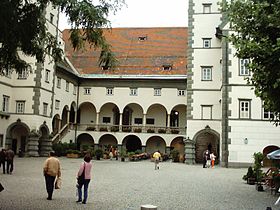
Carinthia (German: Kärnten, Italian: Carinzia, Slovenian: Koroška) is the southernmost Austrian state or Land; it is chiefly famous for its mountains and lakes.
It covers an area of 9,536 km² with 559,404 inhabitants (2001).
It consists mostly of a basin inside the Alps, with the Carnian Alps and the Karawanken making up the border to Italy and Slovenia. The Tauern mountains divide it from Salzburg. To the East lies the state of Styria and it makes up a continuous valley with the eastern part of the Tyrol to the West. Its lakes are a major tourist attraction. The main river is the Drave.
The capital is Klagenfurt (Slovenian: Celovec). The next important town is Villach (Slovenian: Beljak); these two towns are strongly linked economically. Other towns and villages include Malta.
The people are predominantly German-speaking with a unique (and easily recognizable) dialect. A Slovenian minority of about 14,000 people (unofficial est. 40,000-50,000) is concentrated in the southeast of the country.
The current governor (German: Landeshauptmann) is Jörg Haider of the Alliance for the Future of Austria (BZÖ). Haider is a rather controversial figure because his politics tend to the far right. He has made a few statements of a xenophobic nature and some suggesting nostalgia for the Third Reich.
Carinthia's main industries are tourism, electronics, engineering, forestry and agriculture. The multinational corporations Philips and Siemens have large operations there.
Carinthia has a continental climate, with hot and moderately wet summers and long harsh winters. In recent decades winters have been exceptionally arid. Average sun index is the highest in Austria. In autumn and winter temperature inversion often dominates the climate, characterised by air stillness, a dense fog covering the frosty valleys and trapping pollution to form smog, while mild sunny weather is recorded higher up in the foothills and mountains.

Klagenfurt (Slovenian: Celovec), is the capital of the federal state of Carinthia (German Kärnten), in Austria, on the Glan river.
It has a population of just over 90,000. Around 1,700 Carinthian Slovenes, roughly one tenth of the total Slovenian minority in Carinthia, live in Klagenfurt.
History
Founded by the Count of Carinthia as a stronghold across the commercial routes in the area, it is mentioned for the first time in the late 12th century as Forum Chlagenvurth. That settlement occupied an area who was subject to frequent floods, so in 1246 duke Bernhard von Spanheim founded it again in a more secure position. It received city rights in 1252.
In the following centuries it suffered fires, earthquakes, grasshoppers invasions and ravages brought by the Peasants Wars. In 1514 a fire destroyed almost completely the city, and Emperor Maximilian I, unable to rebuild it, ceded it to the Regional Parliament. This brought a revival and an economical Renaissance for Klagenfurt, with, in particular, the construction of the Neuer Platz (new city centre) by the Italian architect Domenico de Lalio, and a new line of walls.
In 1809 the French troops under Napoleon destroyed the city walls, leaving only a small stretch now visible. In 1863 the railway connection boosted the city economy, turning it into the most important centre of the region.

Main sights
The Old City with its central Alter Platz (Old Square) is also worth seeing. Notable landmarks include
- Wörthersee, the warmest European Alpine lake
- the Lindwurm Brunnen (a lindworm fountain)
- Hochosterwitz Castle, an impressively fortified castle on a high hill that can only be reached by an ascending spiral path which is fortified with a series of gates.
- Papace of the Regional Parliament.
- The Cathedral.
Culture
It is a popular vacation spot with mountains to both the south and north, numerous parks and a series of 23 castles on its outskirts. In summertime the city is home to the Altstadtzauber (The Magic of the Old City) festival, Ironman Contest and the Ingeborg Bachmann Preis, a prize for German literature.
Also located here are the University of Klagenfurt and Klagenfurt Airport. Among other Austrian educational institutions, there is also the Slovenian non-classical Gymnasium.
In addition to cultural attractions and activities available in and around Klagenfurt, this city has one more important attribute that must be mentioned. Klagenfurt is in a central location to many other great European destinations. In the heart of Europe, Klagenfurt is only a couple of hours from Italy, Slovenia, Vienna, Salzburg, Hungary, and much more. Local residents in Klagenfurt have the luxury of being able to access these culturally diverse regions with relative ease.
Sports
The Austrian Ice-hockey record-champion EC KAC [1] is one of the most famous sports clubs in Austria. The "Eishockey Club Klagenfurter Athletik Club" has won the Austrian Championship 28 times and attracts fans from allover Carinthia.
The 2nd League Football club FC Kärnten is based in Klagenfurt.
Klagenfurt hosts the Start/Finish of the Austrian Ironman Triathlon, part of the ITU Ironman World Cup series.
Famous people
Famous residents include Josef Stefan, Robert Musil, Anton Webern and Ingeborg Bachmann. Nearby, near the town of Maiernigg, is the former summer home of Gustav Mahler.
 View at the Lendkanal in the center of Klagenfurt |  The Stadthaus |  Klagenfurt War Cemetery |  Klagenfurt Cathedral |
Well known International Schools
IBG Ingeborg Bachmann High School
BORG Klagenfurt





No comments:
Post a Comment